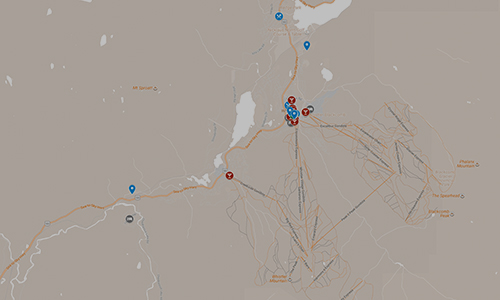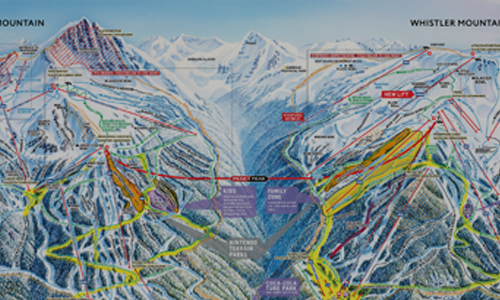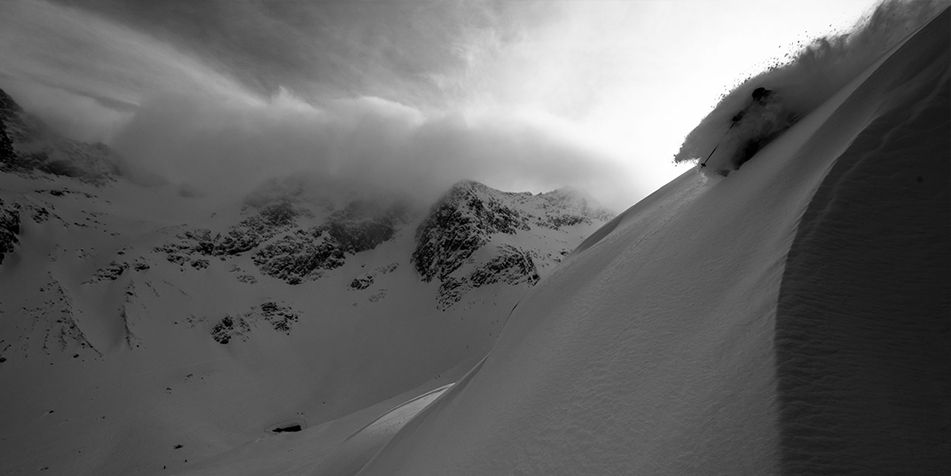Whistler Blackcomb
Ensuring skiing’s future
[vc_row][vc_column width=”4/12″][ultimate_info_table design_style=”design06″ color_scheme=”custom” color_bg_main=”#ffffff” color_txt_main=”#4a4a4a” color_bg_highlight=”#556a99″ package_heading=”THE STAT SHEET” package_sub_heading=”Whistler Blackcomb by the numbers” subheading_font_size=”desktop:14px;” features_font_size=”desktop:14px;”]
Snowfall: 461 inches
Acreage: 8,171
Vert: 5,280 feet
Trails: 200+
Lifts: 37
BC Gates: 2
Parks: 5
TRAIL BREAKDOWN
Beginner: 17.75%
Intermediate: 55%
Advanced: 27.25%
SLOPE ASPECTS
North-facing: 55%
East-facing: 2%
South-facing: 3%
West-facing: 40%
[/ultimate_info_table][/vc_column][vc_column width=”6/12″][vc_column_text]
Whether you’ve never set foot on a mountain or do so everyday, stories of challenges facing the ski industry are unavoidable. Some arrive packaged with the broader issue of climate change: Less predictable weather patterns are impacting the temperatures and precipitation required for reliable snow surfaces in certain areas. Some come wrapped around the drama and seeming desperation related to these vicissitudes: ski areas shuttered for entire seasons; European resorts deploying insulating blankets to preserve their glaciers. Still, others are simply part of a changing recreational landscape: fewer people taking up snowsports for a myriad of leisure-trend reasons.
For those in snow business, these are the harsh realities. But for the folks at Whistler Blackcomb (WB), a question posed long ago—Do we want to thrive in this environment or merely survive?—has an obvious answer. Choosing proactive over reactive, WB set out to thrive, something it clearly achieved in leading the way for other resorts.
[/vc_column_text][/vc_column][vc_column width=”2/12″][/vc_column][/vc_row][vc_row][vc_column][vc_column_text]
“I think we’ve shown a track record… that’s what’s really important when people step back and look at what we’ve done,” says CEO Dave Brownlie. “You’ve got to go ‘You know what? We’ve done a lot of the right things. Not everything is perfect. We’re going to make mistakes as everybody does. But you don’t hit the home run unless you swing the bat, and that’s kind of what we’re all about.’”
Take the important issue of creating new skiers and snowboarders. According to the Colorado-based National Ski Areas Association (NSAA), over a million first-timers tried skiing or snowboarding last season, 68 percent were under age 35. That sounds promising, but coupled with an overall decline in participation and reported 20-percent drop in the number of U.S. ski areas in the past two decades—and comparable numbers elsewhere—it still adds up to a negative. If the snowsports industry were a small country (which, in the larger Republic of Recreation, it very much is), this is equivalent to a negative birth rate.
[/vc_column_text][/vc_column][/vc_row][vc_row][vc_column][vc_single_image image=”64494″ img_size=”full” add_caption=”yes” alignment=”center”][/vc_column][/vc_row][vc_row][vc_column][vc_column_text]
Countering with great introductory packages and incentives in the local market, WB has advanced a range of other initiatives. One is new technologies (tracking apps and other electronic tools like Whistler Blackcomb Live and WB+) which are not only invaluable for engaging digital-savvy youth, but also offer new ways for long-term skiers to enlarge the conversations about their sport in ways that might attract others. Another is supporting smaller ski hills. “Those ski areas generate new skiers,” says Brownlie, speaking to pulling together as a community. “If we can help everybody get better, hopefully we can raise that tide and ultimately raise the number of people that want to ski and snowboard.”
Current climate trends, however, remain WB’s greatest challenge, demanding responses to everything from shrinking season length to fire preparedness. With less snow predicted for lower elevation slopes in the future, increasing sub-alpine and alpine lift capacity has been an important part of WB’s business model for a decade. Climate resilience was part of the thinking behind installing Symphony chair, upgrading Harmony and Crystal lifts and the installation of the Peak 2 Peak gondola, which opened in 2008 to link alpine zones on both Whistler and Blackcomb. Though these infrastructure changes make sense, achieving them required some upstream swimming.
[/vc_column_text][/vc_column][/vc_row][vc_row][vc_column][vc_single_image image=”64771″ img_size=”full” alignment=”center”][/vc_column][/vc_row][vc_row][vc_column][vc_column_text]
To some, the Peak 2 Peak was a costly, hare-brained idea that came with too many hurdles. Convinced the project’s viability lay in boosting the resort’s seasonal offerings and thus solidifying WB’s reputation as a preeminent four-season mountain resort, Brownlie played rainmaker to get ’er done. A resounding success from day one, the Peak 2 Peak has silenced even the most entrenched naysayers. “It’s about doing new things, new things that maybe everybody isn’t agreeing with,” says Brownlie. “In this business if you’re not moving forward you’re probably falling behind.”
[/vc_column_text][/vc_column][/vc_row][vc_row][vc_column width=”2/12″][/vc_column][vc_column width=”8/12″][vc_column_text]
Unafraid to break trail on climate issues, WB has taken other mad-scientist-like steps. In 2015 it began an experiment to rebuild Blackcomb’s receding Horstman Glacier. “Snowgun snow is a more resilient molecule than natural snow. And we’ll put snow where we’re having the biggest challenges from glacier melting,” announced Doug McFarlane, director of operations. “We already have a much different snow profile than 25 years ago, so if we don’t try this, we know what’s going to happen—and we think it will make a difference.”
Although the effect of climate change on snowfall is an industry-wide concern, operators are adapting according to Geraldine Link, director of public policy at NSAA, referencing significant member investments in efficient snowmaking and grooming technologies to create reliable, high-quality surfaces in both the early season and low-snow years. That’s great for resorts in interior western North America, where temperatures are cooler and there’s potential to expand operations upward, but ski areas elsewhere can’t rely solely on snowmaking to bail them out of warmer weather. Starting this fall, Minnesota’s Buck Hill will offer skiing on runs carpeted by slick plastic bristles. Neveplast—the Italian-made artificial surface—works at any temperature, doesn’t require water for lubrication, and can be left in place when the snow falls. A first for the U.S. (Neveplast slopes are common in Australia and parts of Europe, including Britain) it offers a hedge when snowmaking fails, creating the ability to ski any day, any season, with new opportunities for both recreation and training.
While this might seem a tad reactive, Link also notes resorts are reducing their own climate impacts through the association’s Sustainable Slopes program. Thirty resorts participated in 2014, lopping off a combined 1,700 tons of carbon dioxide emissions from buildings, vehicles and electricity use.
[/vc_column_text][vc_empty_space height=”50px”][/vc_column][vc_column width=”2/12″][/vc_column][/vc_row][vc_row full_width=”stretch_row_content_no_spaces”][vc_column][cq_vc_parallax images=”64773,64496″][/cq_vc_parallax][/vc_column][/vc_row][vc_row][vc_column][vc_empty_space height=”50px”][vc_column_text]This kind of environmentally-forward thinking has been central to WB’s mission for decades, but it was a mistake—a 1992 diesel spill into a stream on Blackcomb — that helped institutionalize the ethos. Since then, a company-wide sustainability policy underpins employee education, waste reduction, fuel and electricity use, habitat conservation and environmental funding. “Our story of environmentalism is a journey in humility,” notes Mountain Planning and Environmental Resource Manager Arthur DeJong. “We can’t change the impact of past projects, but we can change how we operate today.”
That includes a renewable energy project that produces enough to power the entire resort; heating programs that save nearly 600 tons of carbon emissions annually; staff carpools that save 64,155 kilometers of travel, 86,768 liters of fuel, and 208 tons of emissions a year; and the testing of a hybrid diesel-electric groomer to gain better fuel efficiency. Clearly, the future of resorts in an era of climate change is to be leaders on climate action.
“What we’re trying to do here,” notes DeJong, “is prove that the tourism sector—and all of us—can make significant reductions. Our goal is to have a zero operating footprint.”
Zero means no waste, no carbon, no emissions. That’s beyond ambitious, but there are strong motives: Like all resorts, WB depends on the stunning environment it aims to conserve, a story that was written long before skiing arrived.
Opening Image by Ruben Krabbe[/vc_column_text][/vc_column][/vc_row]



